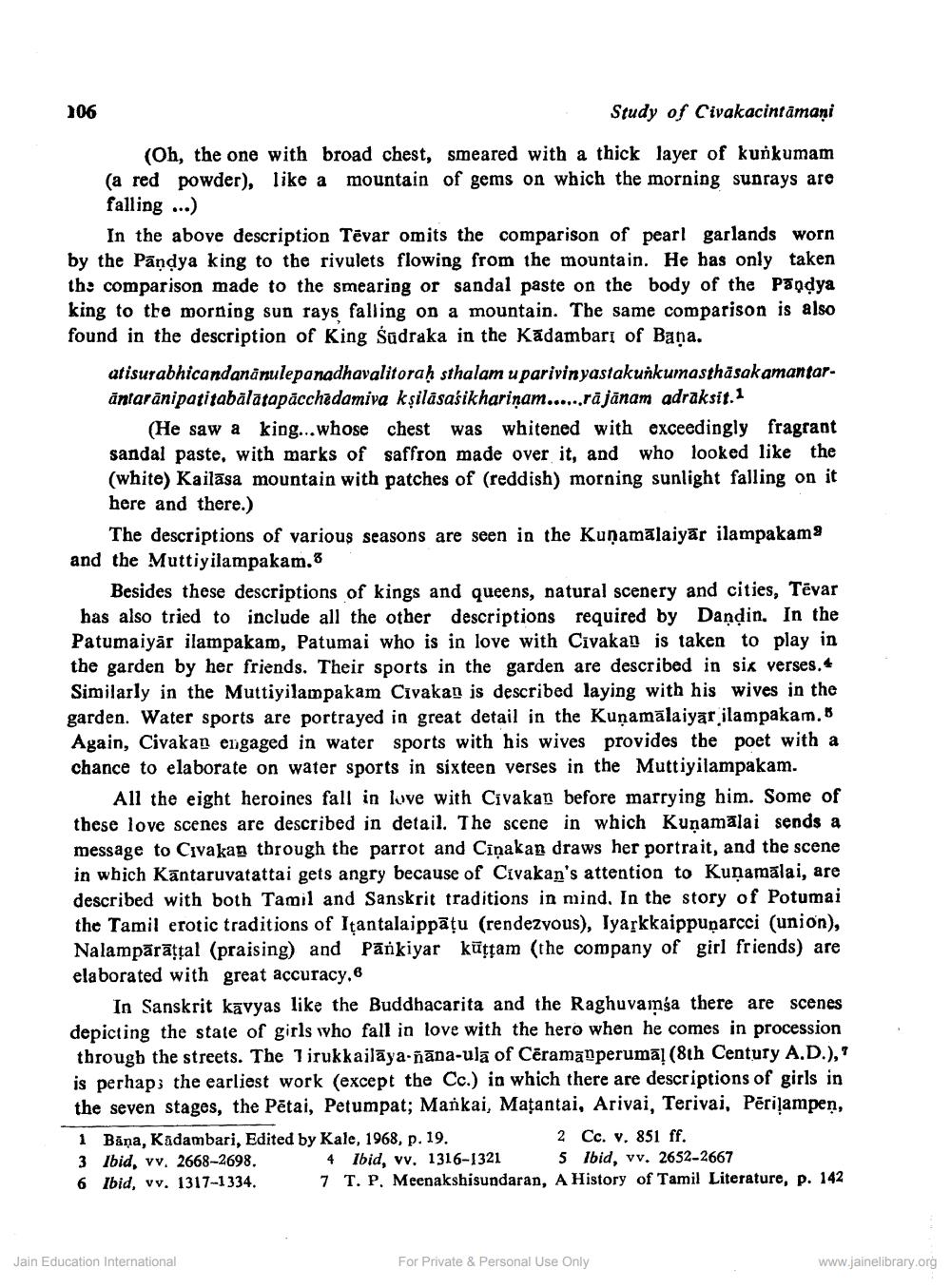________________
206
Study of Civakacintamani
(Oh, the one with broad chest, smeared with a thick layer of kunkumam (a red powder), like a mountain of gems on which the morning sunrays are falling ...)
In the above description Tēvar omits the comparison of pearl garlands worn by the Pandya king to the rivulets flowing from the mountain. He has only taken the comparison made to the smearing or sandal paste on the body of the Pandya king to the morning sun rays falling on a mountain. The same comparison is also found in the description of King Sūdraka in the Kādambari of Baņa.
atisurabhicandananulepanadhavalitorah sthalam uparivinyastakunkumasthāsakamantarantarānipatitabalatapăcchadamiva kşilasasikharinam......räjänam adraksit.1
(He saw a king...whose chest was whitened with exceedingly fragrant sandal paste, with marks of saffron made over it, and who looked like the (white) Kailāsa mountain with patches of (reddish) morning sunlight falling on it here and there.)
The descriptions of various seasons are seen in the Kuņamālaiyār ilampakam and the Muttiyilampakam.
Besides these descriptions of kings and queens, natural scenery and cities, Tēvar has also tried to include all the other descriptions required by Daņdin. In the Patumaiyār ilampakam, Patumai who is in love with Civakan is taken to play in the garden by her friends. Their sports in the garden are described in six verses. 4 Similarly in the Muttiyilampakam Civakan is described laying with his wives in the garden. Water sports are portrayed in great detail in the Kunamālaiyar ilampakam.8 Again, Civakan engaged in water sports with his wives provides the poet with a chance to elaborate on water sports in sixteen verses in the Muttiyilampakam.
All the eight heroines fall in love with Civakan before marrying him. Some of these love scenes are described in detail. The scene in which Kunamalai sends a message to Civakan through the parrot and Cīņakan draws her portrait, and the scene in which Kāntaruvatattai gets angry because of Civakan's attention to Kunamalai, are described with both Tamil and Sanskrit traditions in mind, In the story of Potumai the Tamil erotic traditions of Ițantalaippāțu (rendezvous), Iyarkkaippuparcci (union), Nalampārāļļal (praising) and Pankiyar küțam (the company of girl friends) are elaborated with great accuracy. 6
In Sanskrit kavyas like the Buddhacarita and the Raghuvamsa there are scenes depicting the state of girls who fall in love with the hero when he comes in procession through the streets. The lirukkailāya-ñāna-ula of Ceramāpperumal (8th Century A.D.),? is perhaps the earliest work (except the Cc.) in which there are descriptions of girls in the seven stages, the Pētai, Petumpat; Mankai, Maţantai, Arivai, Terivai, Pēriļampen, 1 Bảna, Kadambari, Edited by Kale, 1968, p. 19.
2 Cc. v. 851 ff. 3 Ibid, vv. 2668--2698. 4 Ibid, vv. 1316-1321 5 Ibid, vv. 2652-2667 6 Ibid, vv. 1317--1334. 7 T. P. Meenakshisundaran, A History of Tamil Literature, p. 142
Jain Education International
For Private & Personal Use Only
www.jainelibrary.org




